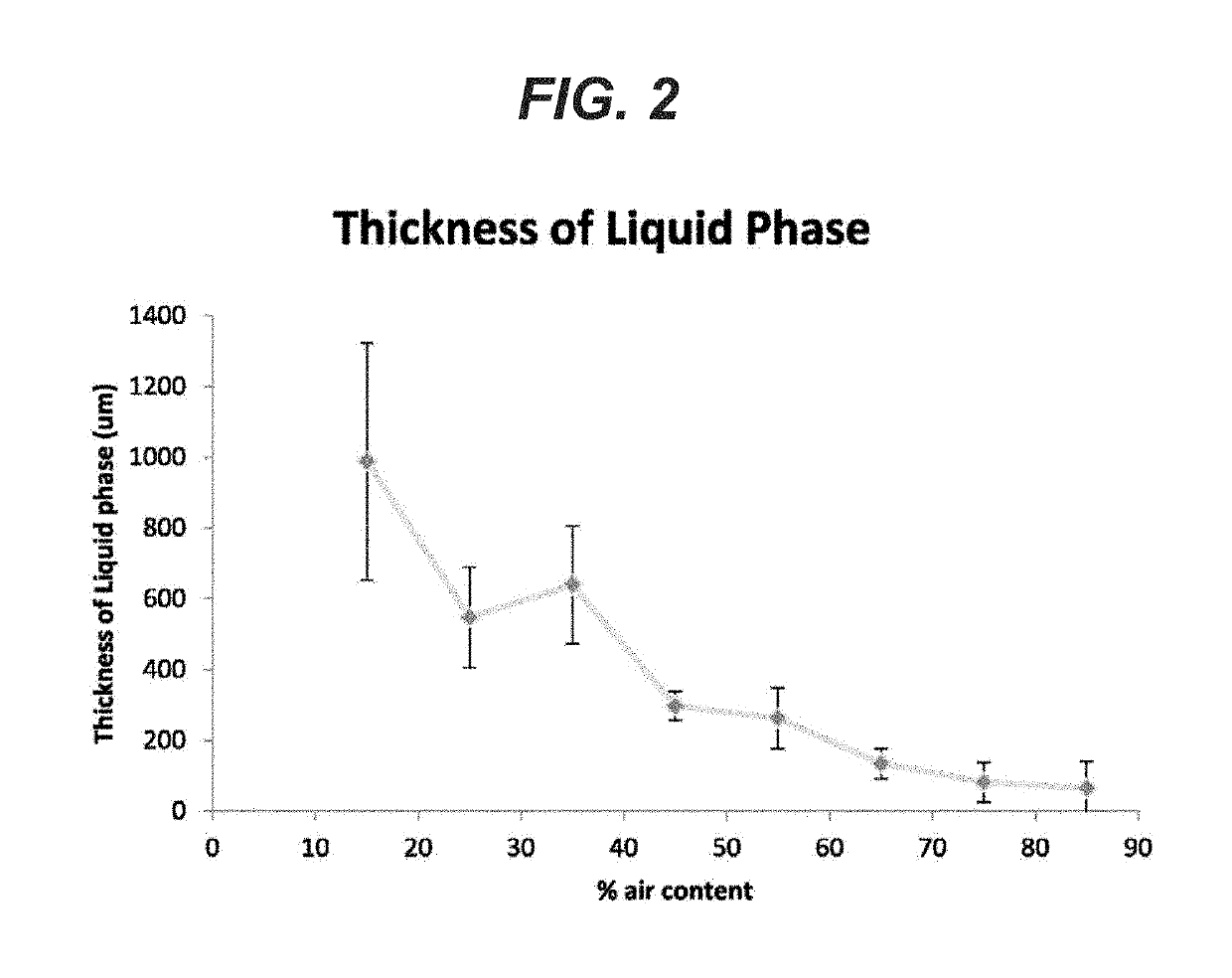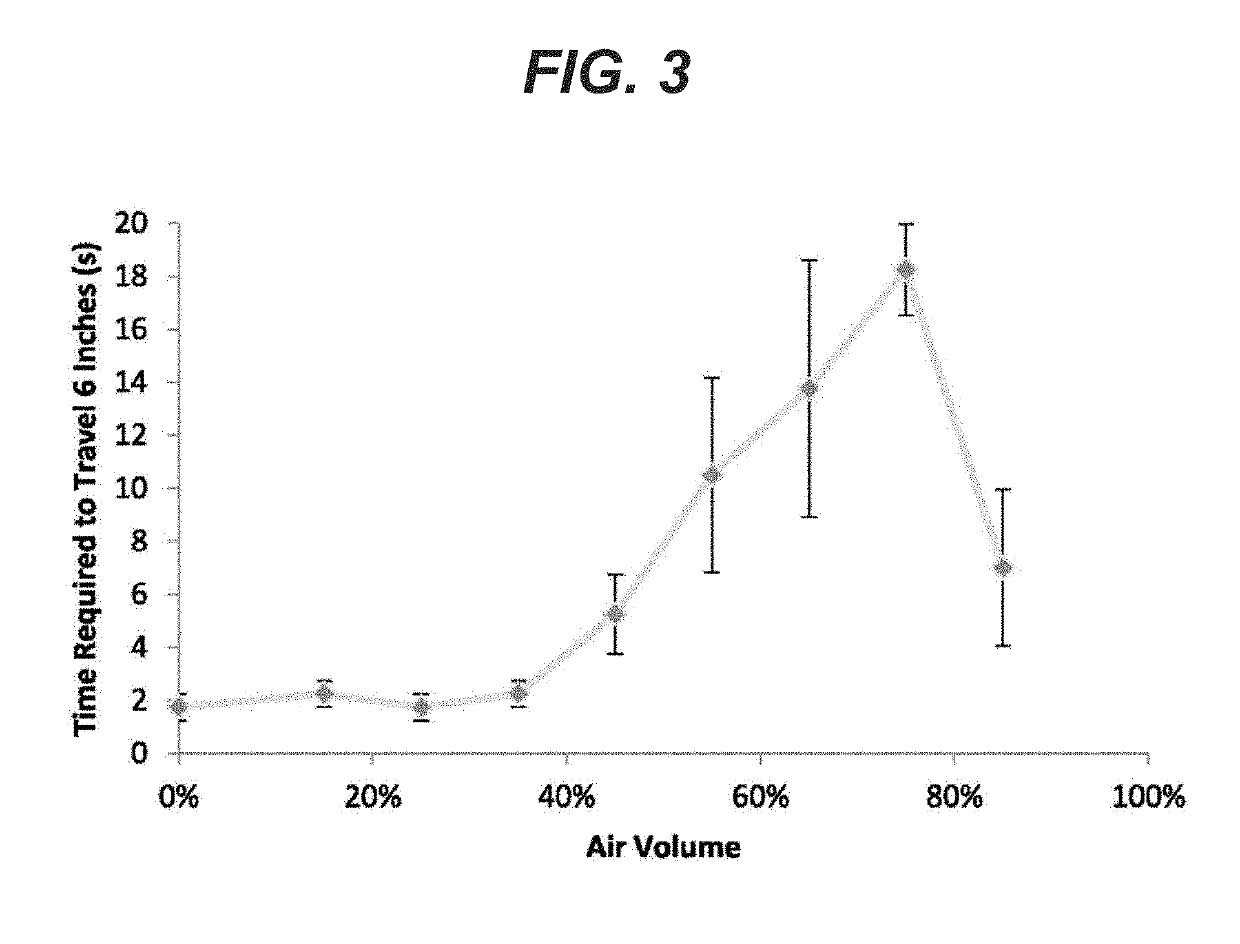Sealant foam compositions for lung applications
a technology of foam compositions and sealants, applied in the direction of surgical adhesives, pharmaceutical delivery mechanisms, surgery, etc., can solve the problems of difficult visualization of liquids at the site of application, difficulty in ensuring adequate coverage of the lung, and difficulty in adjusting the treatment
- Summary
- Abstract
- Description
- Claims
- Application Information
AI Technical Summary
Benefits of technology
Problems solved by technology
Method used
Image
Examples
example 1
paration
[0061]Compliant foams comprising albumin at a concentration of 100 mg / ml of the liquid and 50 mg / ml of PEG-SG-4 having molecular weight of 10 kDa and varying volumes of air (0%, 15%, 25%, 35%, 45%, 55%, 65%, 75%, 85% of total foam volume) were prepared by a syringe exchange method as described below. The starting albumin concentration of the standard foam is 200 mg / ml, but after combining with the PEG-SG-4 in carbonate buffer, the final concentration of albumin is 100 mg / ml.
[0062]In one series of tests, the following materials were used: 200 mg / ml albumin (bovine serum albumin, Sigma) solution; PEG-SG-4 (Jenkem, China.) having molecular weight of 10 kDa; Buffer Carbonate at 100 mM concentration at pH 8; and Air—variable amounts as noted above and described below.
[0063]PEG-SG-4 powder was dissolved in 100 mM carbonate buffer (pH=8.0) to form 100 mg / mL solution. Albumin was dissolved in water to form 20% solution (w / v). 1.25 mL of 20% albumin solution and 1.25 mL of 100 mg / mL ...
example 2
es Distribution (at the Tissue-Foam Interface)
[0065]For the foam to be an effective lung sealant, the presence of air bubbles at the tissue-foam interface is important as it accommodates the change in lung surface and volume during lung inflation and deflation. Minimizing phase separation between the air and liquid is desirable. Foams with various air content (15% to 85% air volume / total volume) were made as described above and deposited on a horizontal flat polymeric surface and allowed to cure at least 10 minutes at room temperature 20-25 C. Once cured, the foams were processed in paraffin using standard histological techniques, sectioned and stained with hematoxylin and eosin (H&E). Referring to FIG. 1, micrographs of cross-sections of the cured foam are presented for foams with variable air (% by volume) content. Representative images of foams including the liquid or non-foamed phase as a function of air content are shown with the arrow indicating the liquid phase. The liquid ph...
example 3
ability
[0068]For the foam to be useful in a lung sealant application, it is desirable to have a sealant that coats the tissue surface without running off while undergoing curing or cross-linking or polymerization. Low viscosity sealant will not stay in place long enough to cure and will migrate due to gravitational and other forces present. Foams made with the variable air content as described above were also prepared with similar compositions but having non-reactive PEG components (i.e. PEG with the same molecular weight but having no reactive SG or NHS groups). Such non-curing formulations were evaluated in order to eliminate the curing aspect of the foam for the flowability analysis. The viscosity and flowability of these non-curing foam formulations is expected to closely mimic these of the inventive curing formulations.
[0069]The non-curing foams were prepared using the syringe exchange method as explained in Example 1, but using non-reactive PEG. After forming the foam, 2 mL of...
PUM
| Property | Measurement | Unit |
|---|---|---|
| concentration | aaaaa | aaaaa |
| concentration | aaaaa | aaaaa |
| viscosity | aaaaa | aaaaa |
Abstract
Description
Claims
Application Information
 Login to View More
Login to View More - R&D
- Intellectual Property
- Life Sciences
- Materials
- Tech Scout
- Unparalleled Data Quality
- Higher Quality Content
- 60% Fewer Hallucinations
Browse by: Latest US Patents, China's latest patents, Technical Efficacy Thesaurus, Application Domain, Technology Topic, Popular Technical Reports.
© 2025 PatSnap. All rights reserved.Legal|Privacy policy|Modern Slavery Act Transparency Statement|Sitemap|About US| Contact US: help@patsnap.com



